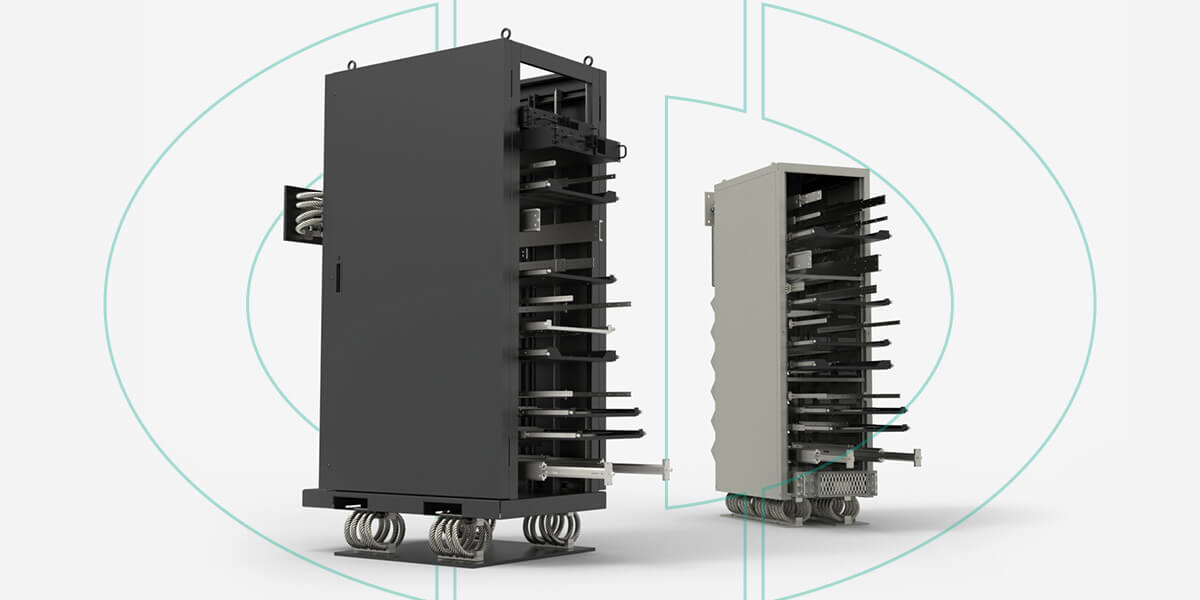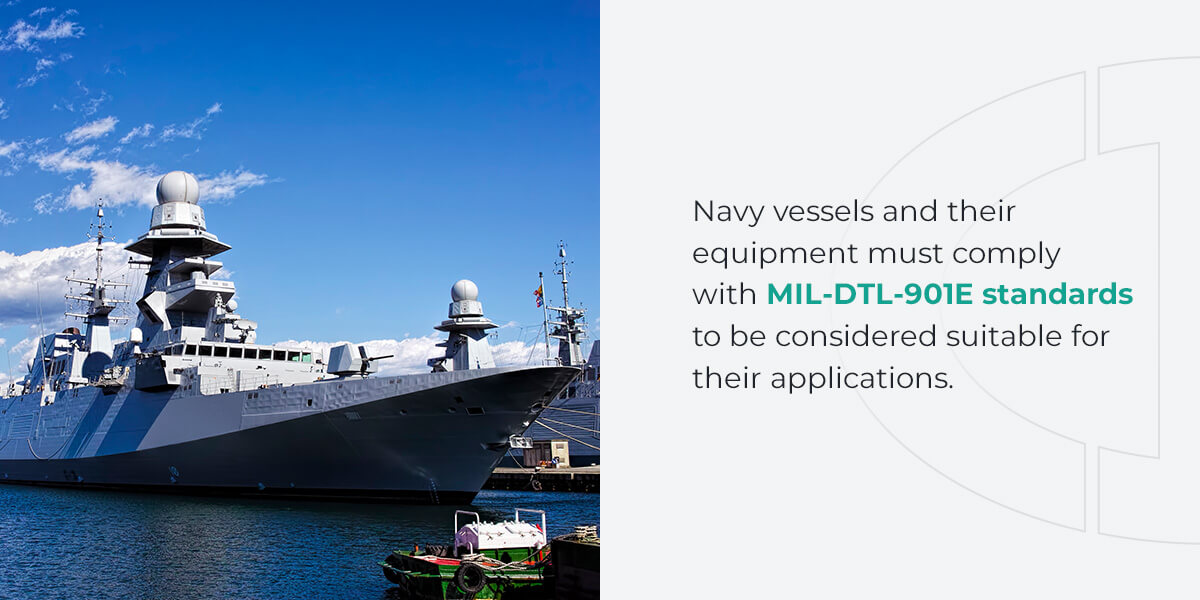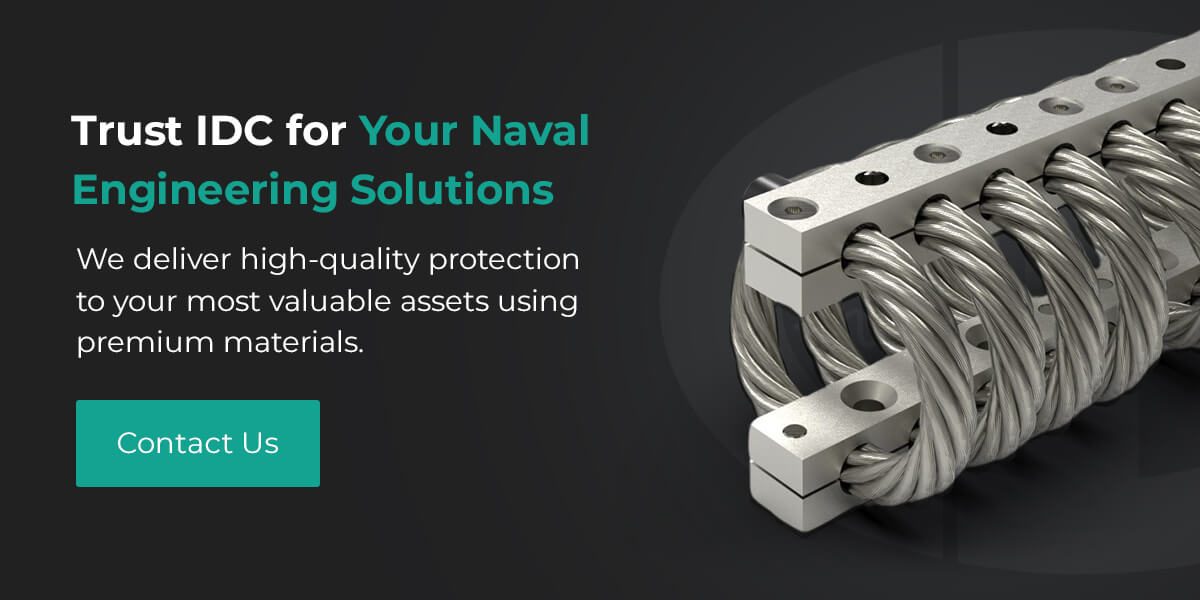What Is MIL-DTL-901E Testing?

Naval engineering is a complex field, and every piece of equipment must be designed to withstand worst-case scenarios while maintaining safety and functionality in the most rugged environments. The MIL-DTL-901E standard describes shock testing methods for mission critical equipment installed on naval ships. To pass 901 shock testing, equipment must survive considerable forces and often continue to work as intended. This ensures that naval ships and submarines can survive and thrive during real world combat scenarios.
Understanding how MIL-DTL-901E testing works is essential for navel equipment engineers. The testing process significantly impacts the design and construction of naval equipment, setting the standard and elevating construction in the maritime industry.
An Overview of MIL-DTL-901E Testing
MIL-DIL-901E mechanical shock testing comprises a set of rigorous tests to evaluate the ability of equipment to withstand shock on naval ships. The primary goal is to establish the safety and reliability of maritime equipment in a harsh environment. Compared to its predecessor, MIL-STD-901D from 1989, the 2017 MIL-DTL-901E has more advanced and detailed testing procedures.
The testing applies to various naval applications, including shipboard machinery, electronics and structures, ensuring they’re rugged enough to endure the challenges of combat scenarios. MIL-DTL-901E subjects this equipment to realistic shock conditions, helping users design and procure robust systems that can withstand the demanding conditions of naval wartime environments, including shock loading due to various weapons and environmental mechanical shock during operation.
The Significance of MIL-DTL-901E Testing
Enhancing the survivability and reliability of equipment on naval vessels is essential for their performance in hazardous conditions. MIL-DTL-901E testing provides equipment functionality data that engineers can use to pinpoint and correct any weaknesses. In addition, these high-impact shock tests significantly affect the design and construction of naval equipment and components.
Naval system survivability must be accurately assessed, and mission-critical systems must be constructed and proven to work consistently in harsh or battle environments. As such, the MIL-DTL-901E describes the test procedures for high-impact shock testing, making it possible for manufacturers to prove their products’ suitability for naval applications at a reasonable cost.
MIL-DTL-901E Test Methods
The MIL-DTL-901E delineates the most vigorous testing procedures for high-impact mechanical shock testing. It specifies different test methods, including:
- Lightweight shock test methods: These tests are performed on land using shock machines. The “hammer test” constitutes weight drop from different heights to impart transient shock to the test article.
- Medium-weight shock test methods: Medium-weight tests are performed similar to lightweight tests with a heavier hammer and capabilities to accommodate larger pieces of equipment. Lightweight and medium-weight machines are only allowed for hull-mounted equipment.
- Deck simulating shock machine (DSSM): The medium-weight DSSM is a fast-growing testing method and one of the principal changes of the MIL-DTL-901E revision. DSSM testing generates controlled mechanical shocks using a drop mechanism that strikes the platform.
- Floating Shock Platform (Barge Test): The Floating Shock Platform is used to perform heavy-weight tests using explosives in a deep water reservoir. Explosives are placed at various depths and distances from the test article. When detonated, they deliver a significant impact on the platform and the equipment installed on it. After each detonation, the equipment is evaluated to determine any damager or deficiencies. All deck-mounted equipment must undergo heavy-weight or DSSM testing methods.
MIL-DTL-901E Test Classifications
To meet MIL-DTL-901E compliance, tested items are evaluated according to two grades:
- Grade A: Essential items to the vessel’s safety and ability to continue functioning after an impact. As these items support the most critical elements of the vessel, they should not fail under a MIL-DTL-901E test and must remain fully operational after testing.
- Grade B: Items that are inessential to the vessel’s safety and capabilities in a combat situation but could represent a danger to personnel or the ship due to shock exposure. While these items must remain intact and not be a potential safety hazard, they do not need to be fully operational after testing.
Equipment is further classified under MIL-DTL-901E by whether isolation devices are required in their installation. These classes include:
- Class I: This equipment must meet the relevant shock testing requirements with no isolation devices installed.
- Class II: Class II equipment is required to meet shock requirements in the presence of assistance from isolation devices.
- Class III: Equipment that has shipboard applications with resilient mounts and in their absence. These components must meet the requirements laid out in both class I and II.
Class II can be challenging to interpret, as shock isolation devices differ in engineering and configuration. Any changes in the deployment that result in conditions different from those during the MIL-DTL-901E may result in less reliable results. Isolation devices for class II equipment must meet the precise configuration of the test conditions and provide consistent results.
Understanding MIL-DTL-901E Compliance

Navy vessels and their equipment must comply with MIL-DTL-901E standards to be considered suitable for their applications. Manufacturers providing the Navy with such equipment must design and test their products to meet MIL-DTL-901E requirements to maintain compliance.
The MIL-S-901D standard served the industry well for nearly 30 years but intentionally provided some flexibility in achieving the relevant performance requirements. Over time, that flexibility became ambiguous, allowing for latitude in testing processes. As a result, the fundamentals of safety and survivability came into question, and compliance claims were no longer trustworthy at face value. MIL-DTL-901E corrects many of these issues, leaving little to interpretation regarding compliance and updating the standards for modern applications.
Meeting the test parameters also gives manufacturers data proving their products are durable and reliable, even in the most challenging circumstances. Confirming that a solution complies with MIL-DTL-901E is critical before investing and fielding it. Users must verify the test methods and parameters and establish whether the tests occurred in an internal or independent test facility.
Future MIL-DTL-901E Testing Methodologies
As the primary purpose of MIL-DTL-901E testing is to ensure the survivability of navy vessels under various challenging conditions, the testing methods will likely advance in line with technologies powering potential weapons. With the surge of artificial intelligence (AI) technologies, simulations will likely come to the fore. Using computer-aided engineering (CAE), testers can conduct a detailed evaluation of the equipment’s full mechanical design, down to the screw attachment points.
MIL-DTL-901E already outlines more comprehensive testing and production procedures than its predecessor, including land testing conditions and extensive diagrams and examples. Many other emerging technologies could simplify future testing processes while providing more accurate results in a broader range of testing contexts. For instance, incorporating sensors and Internet of Things (IoT) technology allows for real-time monitoring of stress levels during testing, potentially resulting in more precise and efficient equipment evaluation.
MIL-DTL-901E aims to make the standard easier to understand and leave less room for ambiguity. As conditions change, the standard will likely evolve to reflect these changes. Using new lightweight materials and composites in equipment design can also impact how mechanical shock testing is conducted. These materials may react differently under challenging circumstances, necessitating updates to MIL-DTL-901E testing procedures to ensure continued effectiveness.
Trust IDC for Your Naval Engineering Solutions
Naval equipment must perform in the most challenging conditions. Many components in military and defense applications require the highest shock and vibration protection levels. IDC is an expert when it comes to shock and vibration applications, and MIL-DTL-901E applications are no exception. IDC’s isolators and engineering support are vital for keeping naval equipment performing optimally during combat and other challenging conditions.
Our defense equipment vibration isolators and isolation assemblies are trusted to protect mission-critical equipment. We deliver high-quality protection to your most valuable assets using premium materials and advanced engineering technology. Contact us today to learn more about our optimized military and defense engineering solutions.
Speak with a Sales Representative
Our representatives have a wealth of knowledge on all our products – let them steer you in the right direction.
Learn More



